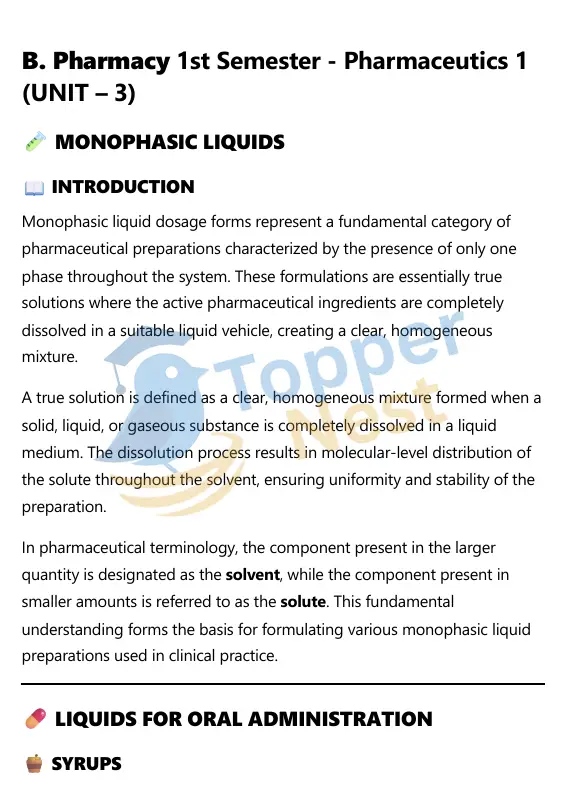Liquid dosage forms are a crucial part of pharmaceutical preparations. They are classified based on their physical nature, typically into monophasic (single-phase) and biphasic (two-phase) systems. This unit explores various types of liquid preparations, including their definitions, classifications, formulation methods, and stability considerations.

Monophasic Liquid Dosage Forms
Monophasic liquid dosage forms are a class of pharmaceutical preparations characterized by their homogeneity, meaning they consist of a single phase. In these systems, the active drug substance and all excipients are completely and uniformly dissolved in a suitable liquid solvent.
The most common solvent is water, but other solvents like alcohol, glycerin, or propylene glycol are also used, often in combination with water.
Major Types of Monophasic Liquid Dosage Forms
Monophasic forms are classified based on their composition and intended route of administration.
1. Oral Solutions
These are solutions intended to be administered by mouth. They are often sweetened and flavored to improve palatability.
2. Oral Rehydration Solutions (ORS)
These are aqueous solutions of electrolytes and carbohydrates (like glucose) used to rehydrate patients who have lost fluids due to conditions like diarrhea.
3. Solutions for Injection (Parenterals)
These are sterile solutions administered via injection. They are a critical class of monophasic liquid forms because they bypass the digestive system, providing a rapid and complete drug response.
4. Topical Solutions
These are solutions intended for application to the skin or mucous membranes.
5. Ophthalmic, Nasal, and Otic Solutions
These are solutions specifically formulated for application to the eye, nose, and ear, respectively. They require special considerations for sterility, pH, and tonicity to ensure safety and comfort.
Biphasic Liquid Dosage Forms
Biphasic liquid dosage forms are pharmaceutical preparations that are heterogeneous, meaning they consist of two distinct, immiscible phases. In these systems, one phase is finely dispersed throughout the other. Since the components are not fully dissolved in each other, these preparations require shaking before use to ensure a uniform distribution of the drug for accurate dosing.
The two main types of biphasic liquid dosage forms are suspensions and emulsions.
1. Suspensions
A suspension is a biphasic system where solid drug particles are finely and uniformly dispersed in a liquid vehicle. The solid particles are insoluble in the liquid, so they must be kept from settling too quickly.
Key Characteristics of Suspensions:
- Insolubility: The active drug substance is insoluble in the solvent.
- Physical Instability: Suspensions are inherently unstable. The solid particles tend to settle at the bottom over time due to gravity. This is why the instruction “Shake Well Before Use” is crucial for patient safety.
- Particle Size: The size of the suspended particles is a critical factor. They are typically between 0.5 and 50 micrometers. Smaller particles settle more slowly.
- Stability: Formulators use various excipients, such as suspending agents (e.g., cellulose derivatives, gums) and wetting agents, to increase the viscosity of the liquid and prevent the particles from settling too quickly or forming a hard cake.
2. Emulsions
An emulsion is a biphasic system where two immiscible liquids are mixed, with one liquid dispersed as tiny droplets within the other. To prevent the two phases from separating, an emulsifying agent is added
Key Characteristics of Emulsions:
- Immiscibility: Consists of two liquids that do not mix (e.g., oil and water).
- Emulsifying Agent: A stabilizing agent (e.g., gums, proteins, surfactants) is essential to reduce the interfacial tension between the two liquids, forming a stable emulsion.
- Globule Size: The dispersed liquid is in the form of small globules (droplets), typically ranging from 0.1 to 100 micrometers.
- Physical Instability: Emulsions can be physically unstable and may undergo creaming (separation of the dispersed phase), flocculation, or coalescence (droplets merging).
FAQs – Monophasic & Biphasic Liquids
1. What is the main difference between monophasic and biphasic liquid dosage forms?
Monophasic liquids are single-phase solutions (e.g., syrups, elixirs), while biphasic liquids have two phases such as solid-in-liquid (suspensions) or liquid-in-liquid (emulsions).
2. Why are suspensions preferred for poorly soluble drugs?
Suspensions allow insoluble drugs to be evenly dispersed in a liquid vehicle, improving dosage flexibility and bioavailability.
3. What is the role of emulsifying agents?
They stabilize emulsions by reducing surface tension and preventing separation of the oil and water phases.
4. How can we identify the type of emulsion?
Using simple tests like the dilution test, dye test, and conductivity test, the nature of the emulsion (O/W or W/O) can be determined.
5. What are the challenges in formulating biphasic systems?
Biphasic systems are prone to instability, such as sedimentation in suspensions or phase separation in emulsions. Proper selection of stabilizers and excipients is essential.
